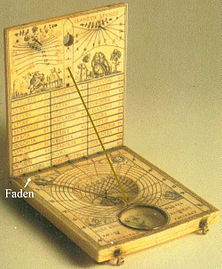Portable sundial
A portable sundial (also known as a travel sundial ) is a sundial that cannot be permanently installed or assembled. Fixed sundials usually measure the hour angle of the sun directly, whereby they have to be aligned against the cardinal points.
Portable sundials are mostly elevation sundials with which the elevation angle of the sun is measured and, after evaluation, is displayed as the time with the known necessary declination (or the year date) of the sun . As a rule, you also have to know whether it is morning or afternoon, because a certain altitude angle can be measured twice a day.
The following equation shows how the elevation angle is to be coded as the hour angle and thus as the time on the scale of an elevation sundial :
In addition to the dependency on the declination angle, this also includes the dependency on the geographical latitude .
Until the more recent past (around 1900), smaller, conventional sundials (measuring the hour angle) were provided with a small magnetic compass and taken with them when traveling. The compass was used to north such a horizontal small sundial.
A special portable sundial is the portable ring sundial . When in use, it is aligned without additional help. In this way a sundial which measures the hourly angle is obtained, which is similar to a stationary, ring-shaped equatorial sundial and is used in a similar manner.
Since people used to travel not far from home, most portable sundials were only set up for a certain geographical latitude. On some (for example on the second and third sundial shown) the changed geographical latitude, which of course you also had to know, could be set.
The Skiostat, developed around 1858, is a not exactly handy, but still transportable sundial with high, almost minute-precise precision. After manually setting the current geographical latitude with the help of a shadow pointer and a day scale, the north-south direction could be precisely adjusted even without a compass.
Portable elevation sundial as a pawn's ring , parallel declination circles
Portable horizontal sundial + compass. Pole rod : on adjustable thread, extra: 1 scaphe + 2 vertical sundials
Portable ring sundial with a hole- mode that can be adjusted to the declination ; Suspension loop on the outer ring -dependently movable.
Individual evidence
- ↑ a b Sundials Handbook , Working Group Sundials in the DGC , 2006, pages 72 to 74
- ^ E. Boissier: August's Sundials. In: Polytechnisches Journal . 149, 1858, pp. 12-16. (Skiostat, with ill.). The Focke Museum in Bremen owns a copy of the device .







